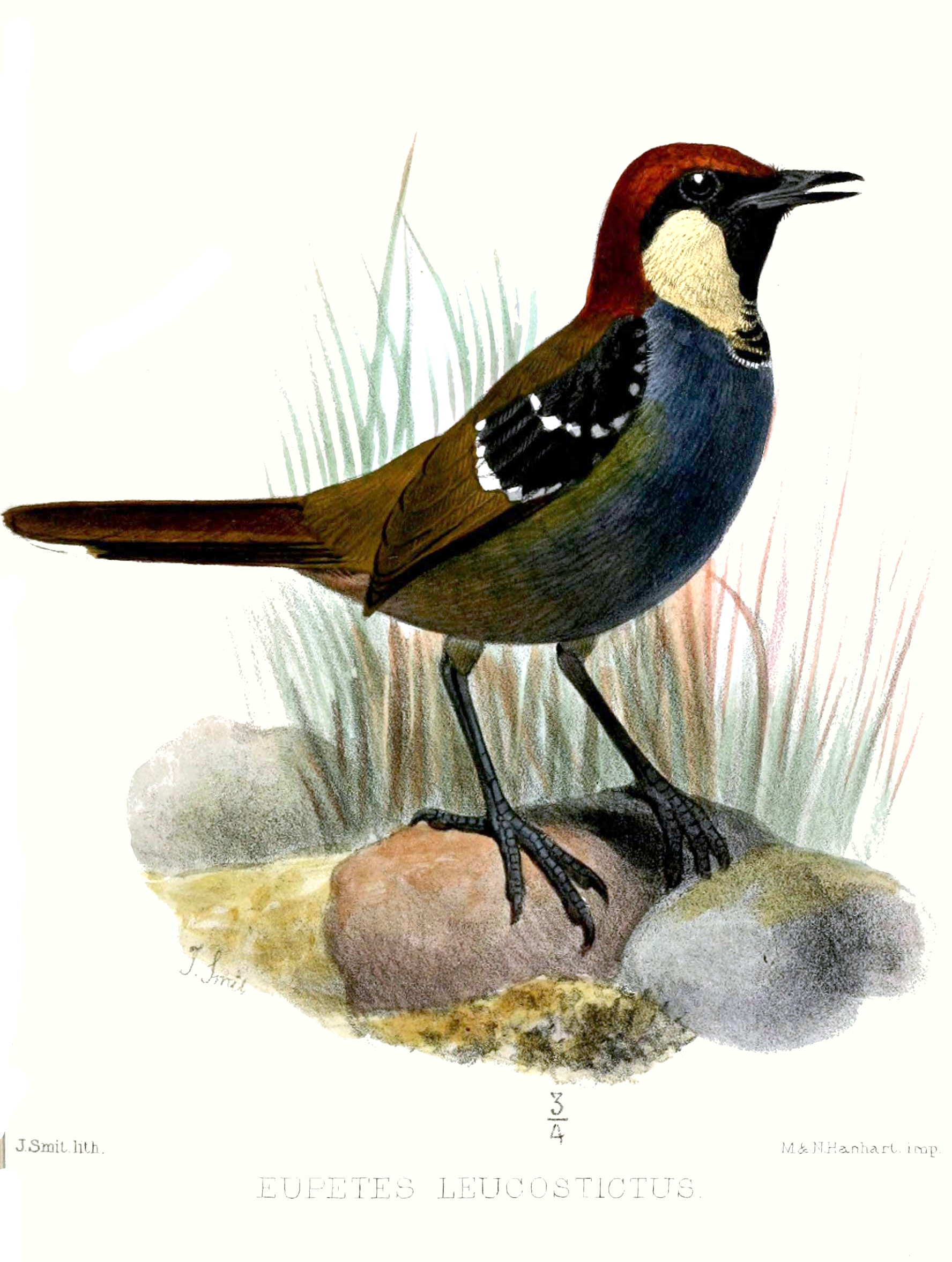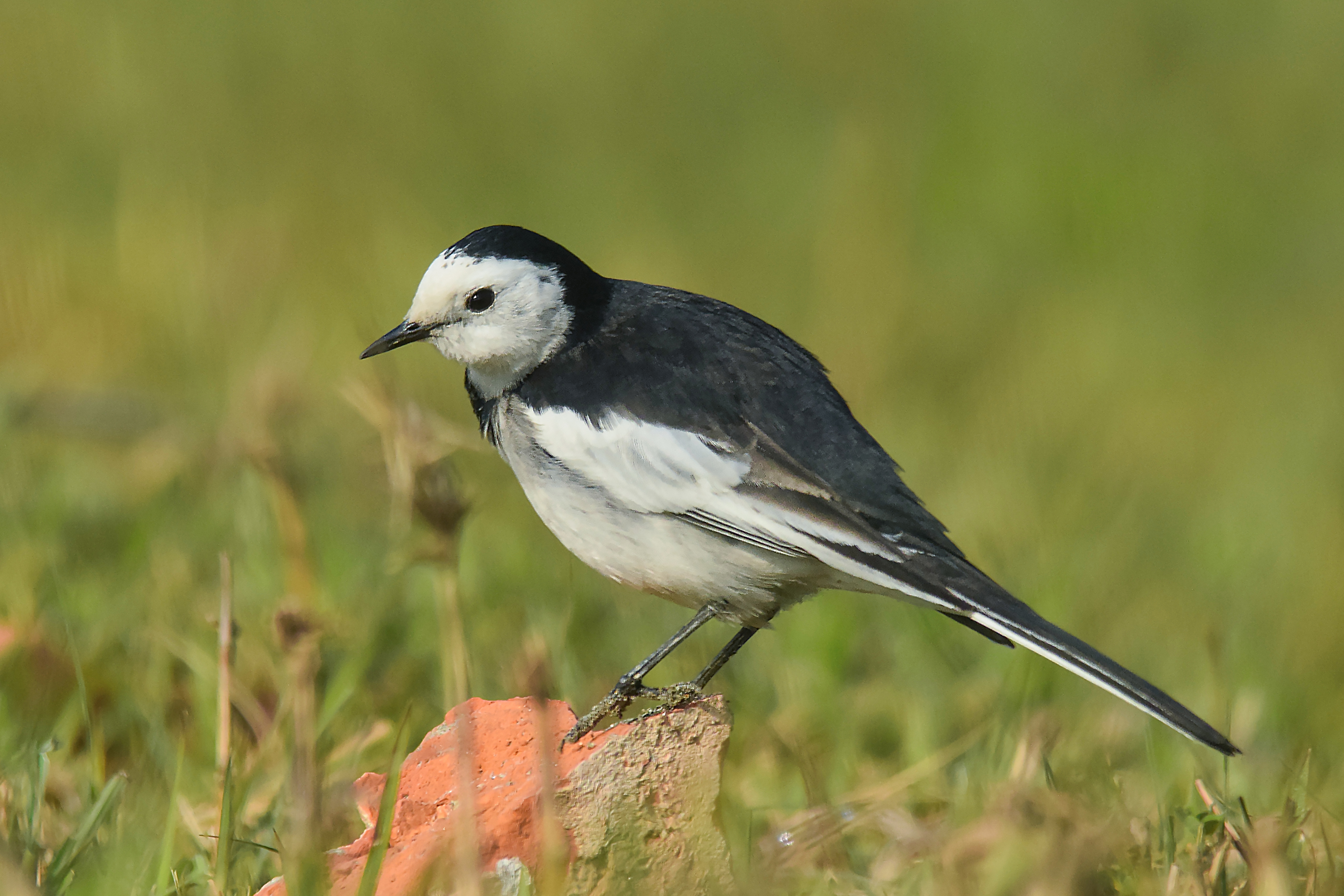|
Jewel-babbler
The jewel-babblers are the bird genus ''Ptilorrhoa'' in the family Cinclosomatidae. The genus contains four species that are endemic to New Guinea. The genus was once considered to contain the rail-babbler, but that species is now considered to belong to its own family. The genus is closely related to the better known quail-thrushes (''Cinclosoma'') of New Guinea and Australia. Together with a number of other genera they comprise the family Cinclosomatidae, although the validity of this family as a whole has been questioned. The jewel-babblers resemble the quail-thrushes in shape, being plump, long-tailed and short winged. They are adapted to life on the forest floor. The plumage of this genus is the most striking divergence from the quail-thrushes, having large amounts of blue and often with chestnut on the back. The throats of all species are white and the patch is mostly surrounded by a black edge. There is moderate levels of sexual dimorphism in the plumage, except in the di ... [...More Info...] [...Related Items...] OR: [Wikipedia] [Google] [Baidu] |
Cinclosomatidae
Cinclosomatidae is a family of passerine birds native to Australia and New Guinea. It has a complicated taxonomic history and different authors vary in which birds they include in the family. It includes the quail-thrushes and jewel-babblers. Taxonomy The quail-thrushes, jewel-babblers, whipbirds and wedgebills were traditionally included with the logrunners (''Orthonyx'') in the family Orthonychidae.Roberson, Don (2004Quail-thrushes Cinclosomatidae Bird Families of the World. Accessed 4 January 2010. Sometimes the Malaysian rail-babbler and blue-capped ifrit (''Ifrita kowaldi'') were also included in the family. In 1985, Sibley and Ahlquist found that the logrunners were not related to the others and included only the logrunners in the Orthonychidae.Christidis, Les & Walter Boles (2008) ''Systematics and Taxonomy of Australian Birds'', CSIRO Publishing. They treated the others as the subfamily Cinclosomatinae within their expanded family Corvidae. A number of authors later tr ... [...More Info...] [...Related Items...] OR: [Wikipedia] [Google] [Baidu] |
Eupetes Castanonotus - The Birds Of New Guinea (cropped)
The rail-babbler or Malaysian rail-babbler (''Eupetes macrocerus'') is a strange, rail-like, brown and pied ground-living bird. It is the only species in the genus ''Eupetes'' and family Eupetidae. It lives on the floor of primary forests in the Malay Peninsula and Sumatra (the nominate subspecies ''macrocerus''), as well as Borneo (ssp. ''borneensis''). It is distantly related to African crow-like birds. Its population has greatly decreased because much of the lowland primary forest has been cut, and secondary forests usually have too dense a bottom vegetation or do not offer enough shade to be favourable for the species. However, it is locally still common in logged forest or on hill-forest on slopes, and probably not in immediate danger of extinction. The species is poorly known and rarely seen, in no small part due to its shyness. Taxonomy Opinions on the correct taxonomic placement for the rail-babbler have differed. At one time, it was placed in the Old World babbler fami ... [...More Info...] [...Related Items...] OR: [Wikipedia] [Google] [Baidu] |
Rail-babbler
The rail-babbler or Malaysian rail-babbler (''Eupetes macrocerus'') is a strange, rail-like, brown and pied ground-living bird. It is the only species in the genus ''Eupetes'' and family Eupetidae. It lives on the floor of primary forests in the Malay Peninsula and Sumatra (the nominate subspecies ''macrocerus''), as well as Borneo (ssp. ''borneensis''). It is distantly related to African crow-like birds. Its population has greatly decreased because much of the lowland primary forest has been cut, and secondary forests usually have too dense a bottom vegetation or do not offer enough shade to be favourable for the species. However, it is locally still common in logged forest or on hill-forest on slopes, and probably not in immediate danger of extinction. The species is poorly known and rarely seen, in no small part due to its shyness. Taxonomy Opinions on the correct taxonomic placement for the rail-babbler have differed. At one time, it was placed in the Old World babbler fami ... [...More Info...] [...Related Items...] OR: [Wikipedia] [Google] [Baidu] |
Ptilorrhoa Caerulescens 1838
The jewel-babblers are the bird genus ''Ptilorrhoa'' in the family Cinclosomatidae. The genus contains four species that are endemic to New Guinea. The genus was once considered to contain the rail-babbler, but that species is now considered to belong to its own family. The genus is closely related to the better known quail-thrushes (''Cinclosoma'') of New Guinea and Australia. Together with a number of other genera they comprise the family Cinclosomatidae, although the validity of this family as a whole has been questioned. The jewel-babblers resemble the quail-thrushes in shape, being plump, long-tailed and short winged. They are adapted to life on the forest floor. The plumage of this genus is the most striking divergence from the quail-thrushes, having large amounts of blue and often with chestnut on the back. The throats of all species are white and the patch is mostly surrounded by a black edge. There is moderate levels of sexual dimorphism in the plumage, except in the dim ... [...More Info...] [...Related Items...] OR: [Wikipedia] [Google] [Baidu] |
Spotted Jewel-babbler
The spotted jewel-babbler (''Ptilorrhoa leucosticta'') is a species of bird in the family Cinclosomatidae. It is found in the highlands of New Guinea. Its natural habitat is subtropical or tropical moist montane forest Montane ecosystems are found on the slopes of mountains. The alpine climate in these regions strongly affects the ecosystem because temperatures fall as elevation increases, causing the ecosystem to stratify. This stratification is a crucial f ...s. References spotted jewel-babbler Birds of New Guinea spotted jewel-babbler spotted jewel-babbler Taxonomy articles created by Polbot {{Cinclosomatidae-stub ... [...More Info...] [...Related Items...] OR: [Wikipedia] [Google] [Baidu] |
Wagtail
Wagtails are a group of passerine birds that form the genus ''Motacilla'' in the family Motacillidae. The forest wagtail belongs to the monotypic genus ''Dendronanthus'' which is closely related to ''Motacilla'' and sometimes included therein. The common name and genus names are derived from their characteristic tail pumping behaviour. Together with the pipits and longclaws they form the family Motacillidae. The willie wagtail (''Rhipidura leucophrys'') of Australia is an unrelated bird similar in coloration and shape to the Japanese wagtail. It belongs to the fantails. Taxonomy The genus ''Motacilla'' was introduced by the Swedish naturalist Carl Linnaeus in 1758 in the tenth edition of his ''Systema Naturae''. The type species is the white wagtail. ''Motacilla'' is the Latin name for the pied wagtail; although actually a diminutive of ''motare'', "to move about", from medieval times it led to the misunderstanding of ''cilla'' as "tail". At first glance, the wagtails appea ... [...More Info...] [...Related Items...] OR: [Wikipedia] [Google] [Baidu] |
Endemic Fauna Of New Guinea
Endemism is the state of a species being found in a single defined geographic location, such as an island, state, nation, country or other defined zone; organisms that are indigenous to a place are not endemic to it if they are also found elsewhere. For example, the Cape sugarbird is found exclusively in southwestern South Africa and is therefore said to be ''endemic'' to that particular part of the world. An endemic species can be also be referred to as an ''endemism'' or in scientific literature as an ''endemite''. For example '' Cytisus aeolicus'' is an endemite of the Italian flora. '' Adzharia renschi'' was once believed to be an endemite of the Caucasus, but it was later discovered to be a non-indigenous species from South America belonging to a different genus. The extreme opposite of an endemic species is one with a cosmopolitan distribution, having a global or widespread range. A rare alternative term for a species that is endemic is "precinctive", which applies to s ... [...More Info...] [...Related Items...] OR: [Wikipedia] [Google] [Baidu] |
Birds Of New Guinea
Birds are a group of warm-blooded vertebrates constituting the class Aves (), characterised by feathers, toothless beaked jaws, the laying of hard-shelled eggs, a high metabolic rate, a four-chambered heart, and a strong yet lightweight skeleton. Birds live worldwide and range in size from the bee hummingbird to the ostrich. There are about ten thousand living species, more than half of which are passerine, or "perching" birds. Birds have whose development varies according to species; the only known groups without wings are the extinct moa and elephant birds. Wings, which are modified forelimbs, gave birds the ability to fly, although further evolution has led to the loss of flight in some birds, including ratites, penguins, and diverse endemic island species. The digestive and respiratory systems of birds are also uniquely adapted for flight. Some bird species of aquatic environments, particularly seabirds and some waterbirds, have further evolved for swimming. Birds ... [...More Info...] [...Related Items...] OR: [Wikipedia] [Google] [Baidu] |
Handbook Of The Birds Of The World
The ''Handbook of the Birds of the World'' (HBW) is a multi-volume series produced by the Spanish publishing house Lynx Edicions in partnership with BirdLife International. It is the first handbook to cover every known living species of bird. The series was edited by Josep del Hoyo, Andrew Elliott, Jordi Sargatal and David A. Christie. All 16 volumes have been published. For the first time an animal class will have all the species illustrated and treated in detail in a single work. This has not been done before for any other group in the animal kingdom. Material in each volume is grouped first by family, with an introductory article on each family; this is followed by individual species accounts (taxonomy, subspecies and distribution, descriptive notes, habitat, food and feeding, breeding, movements, status and conservation, bibliography). In addition, all volumes except the first and second contain an essay on a particular ornithological theme. More than 200 renowned speci ... [...More Info...] [...Related Items...] OR: [Wikipedia] [Google] [Baidu] |
Chestnut-backed Jewel-babbler
The chestnut-backed jewel-babbler (''Ptilorrhoa castanonota'') is a species of bird in the family Cinclosomatidae. It is found in New Guinea. Its natural habitats are subtropical or tropical moist lowland forests and subtropical or tropical moist montane forest Montane ecosystems are found on the slopes of mountains. The alpine climate in these regions strongly affects the ecosystem because temperatures fall as elevation increases, causing the ecosystem to stratify. This stratification is a crucial f ...s. References {{Taxonbar, from=Q1922945 chestnut-backed jewel-babbler Birds of New Guinea chestnut-backed jewel-babbler Taxonomy articles created by Polbot ... [...More Info...] [...Related Items...] OR: [Wikipedia] [Google] [Baidu] |
Brown-headed Jewel-babbler
The brown-headed jewel-babbler (''Ptilorrhoa geislerorum''), also known as the dimorphic jewel-babbler or brown-capped jewel-babbler, is a jewel-babbler in the family Cinclosomatidae. It is now usually considered to be distinct from the blue jewel-babbler, separated altitudinally and by varying behaviour, calls and female plumage. References * Del Hoyo, J.; Elliot, A. & Christie D. (editors). (2007). ''Handbook of the Birds of the World The ''Handbook of the Birds of the World'' (HBW) is a multi-volume series produced by the Spanish publishing house Lynx Edicions in partnership with BirdLife International. It is the first handbook to cover every known living species of bird. T ...''. Volume 12: Picathartes to Tits and Chickadees. Lynx Edicions. {{Taxonbar, from1=Q27075281, from2=Q4976000 Ptilorrhoa Birds described in 1892 ... [...More Info...] [...Related Items...] OR: [Wikipedia] [Google] [Baidu] |
Blue Jewel-babbler
The blue jewel-babbler (''Ptilorrhoa caerulescens'') is a species of bird in the family Cinclosomatidae. It is found in New Guinea. Its natural habitat is subtropical or tropical moist lowland forest A forest is an area of land dominated by trees. Hundreds of definitions of forest are used throughout the world, incorporating factors such as tree density, tree height, land use, legal standing, and ecological function. The United Nations' ...s. References blue jewel-babbler Birds of New Guinea blue jewel-babbler Taxonomy articles created by Polbot {{Cinclosomatidae-stub ... [...More Info...] [...Related Items...] OR: [Wikipedia] [Google] [Baidu] |




.jpg)
.jpg)